In most of the world, reclining Buddha images represent the Buddha at his death. But in Thailand this is usually not the case. Of the seven reclining postures used in Thailand, two are the Buddha on his death bed, one shows him passing to nirvana, and two are for his cremation; but all of these are rather rare. And none of these is the classic hand-holding-up-his-head posture, which tells a story from the prime of his life and is far more common than all other reclining Buddha images combined.1A Buddha image’s posture symbolizes some special episode from the Buddha’s life , but the specific tale is usually completely irrelevant to a person’s worship, so many Thais do not know the associated stories; there’s no need to.
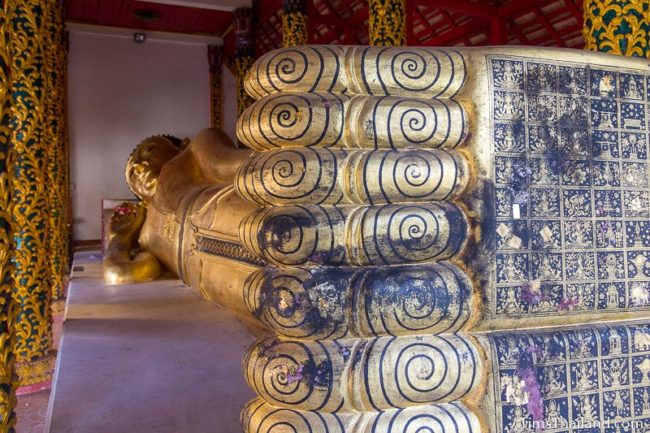
Many reclining Buddha images in Thailand, regardless of which posture, are very large because these are much easier and cheaper to make than ginormous sitting, standing, or walking ones. And many of these large ones have auspicious symbols (usually 108) carved or painted on the soles of the feet; just like those seen in Buddha footprint shrines. These are derived from a list in the Pali Canon and are unrelated to a particular posture’s story.
Preaching to Asurindarahu Posture
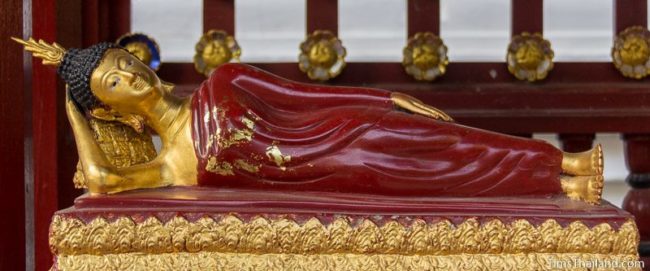
Seen in just about every Buddhist temple in Thailand and composing probably (by my estimate) 90% of all reclining Buddha images, this is the standard reclining posture. Visually symbolizing the Buddha’s calm demeanor, the story attached to it represents the Buddha’s power and wisdom. When he divined that a powerful, arrogant giant named Asurindarahu (usually called Rahu in English, he causes eclipses by eating the sun and moon) was coming to see him, the Buddha made himself so enormous the giant had to look up to see his face. Humbled by the Buddha’s power, Asurindarahu became a follower.
This is the daily Buddha posture for people born on Tuesday.
• Thai name: ปางโปรดอสุรินทราหู หรือ ปางไสยาสน์ / Bang Broht Asurintarahu or Bang Sai Yaht
Dreaming Posture
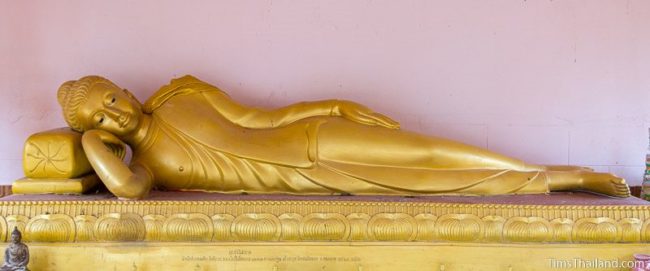
Identified by the Buddha resting his head on the back of his hand with the fingers pointing toward the body, the Dreaming posture’s story occurred the day before the Buddha reached enlightenment. He had spent the last six years pursuing enlightenment through self-torture and self-denial and finally, after remembering the time as a child he had sat in the magically unmoving shade of a tree and did meditation for the first time, decided he was on the wrong path. The search for liberation from suffering and rebirth, he realized, could only come through a Middle Way between asceticism and materialism; through mental, not physical means. The soon-to-be-Buddha ate bean soup to regain his strength and then had five auspicious dreams that he interpreted as predicting that he would for indeed reach enlightenment, that he would teach dharma to men and gods, that people would accept and take refuge in dharma, that people of all four castes would ordain as monks with him, and that he would no longer feel attachment to material things.
This story also often includes an account of a dream during which Indra, king of the gods, played a three-string lute for him. The first string was so tight it snapped when plucked. The second string was so loose it made no sound. The third string was properly tuned so it made a beautiful sound, and this middle string gave him the idea for the Middle Way.
Often the top foot in Dreaming posture statues lies beside the bottom foot rather than atop it, and this is the only posture where this happens. The foot position is an artistic choice and does not affect the story.
• Thai name: ปางทรงสุบิน / Bang Songsubin
Making a Prophecy Posture
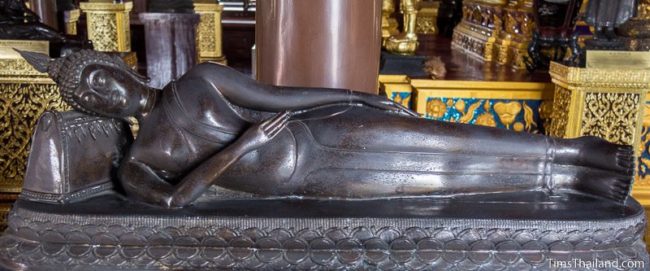
After the frail eighty-year-old Buddha laid down on his deathbed in a small grove outside the remote village of Kusinara, the place he had chosen to die, Ananda, his personal attendant, broke down in tears because his teacher was leaving and he had not yet reached enlightenment. The Buddha told him to stop grieving because everything is impermanent, and he predicted that Ananda would become an arahant, free of all defilements, very soon.
• Thai name: ปางทรงพยากรณ์ / Bang Songpayagawn
Preaching His Final Sermon Posture
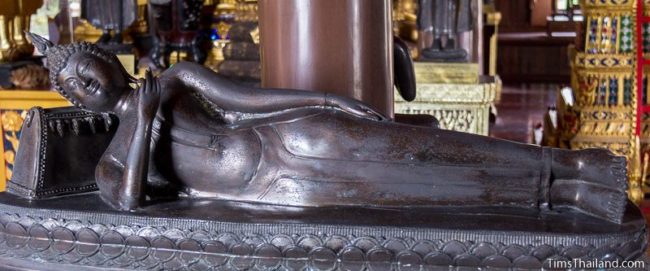
As the Buddha’s disciples and the citizens of Kusinara stood around him to pay their final respects, a wandering ascetic named Subhadda, who followed a different doctrine but had heard much praise of the Buddha, learned that he had announced he was going to die that night and wanted to meet him while he still had the chance. Three times Subhadda asked Ananda for the chance to talk to the Buddha, but each time Ananda said his master was too weary to meet strangers. But the third time Subhadda asked, the Buddha heard his request and told Ananda to let him approach because Subhadda was requesting knowledge about dharma, and the Buddha had divined that Subhadda would be able to grasp it. So the Buddha preached about the noble Eightfold Path and explained that understanding dharma and living a righteous life was the only way to become an arahant; no other teacher’s path could take one there. Subhadda found joy in the Buddha’s words and requested ordination as a monk. The Buddha approved and told Ananda to take his vows right there without the regular four-month probationary period. Subhadda then went to a quiet part of the grove to do walking meditation, and he reached enlightenment soon after. This was the final sermon given by the Buddha, and Subhadda was the last person to be converted by the Buddha himself.
The Buddha is making a circle with his right hand, a symbol of teaching that originated in ancient India.
• Thai name: ปางโปรดสุภัททะ / Bang Broht Supatta
Entering Nirvana Posture
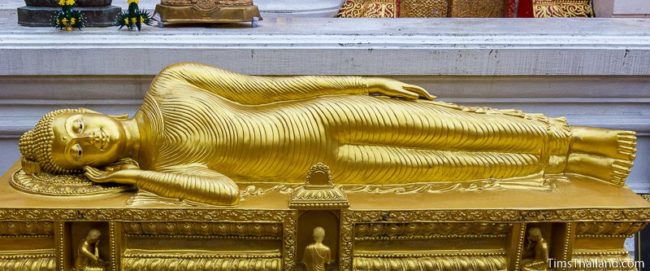
This reclining Buddha image posture in Thailand is the one that shows the Buddha passing to nirvana. After preaching to Subhadda, the Buddha gave final advice and orders to his disciples, urging them to maintain purity and good behavior (such as avoiding wealth like one avoids fire or pits, not cutting down trees, not paying attention to worldly affairs, and not giving horoscopes), resist desire, and let dharma and the monastic code replace him as their teacher. He asked his disciples if they had any final questions about dharma, but they did not. The Buddha’s final words were “Listen well, my disciples, and remember that all things are impermanent. Continue striving to follow dharma.” Then through meditation he passed slowly into nirvana, never to be born again. At that final moment, the earth shook and flowers fell from trees onto his body.
Though it is not very common, this Entering Nirvana posture is the only reclining Buddha posture you are likely to see other than the standard one. The eyes are usually closed. The Buddha’s head may or may not rest on a pillow, and if there is a pillow the arm may lie on it or beside it; none of this affects the story.
• Thai name: ปางปรินิพพาน / Bang Bari Nipan
Cremation Posture
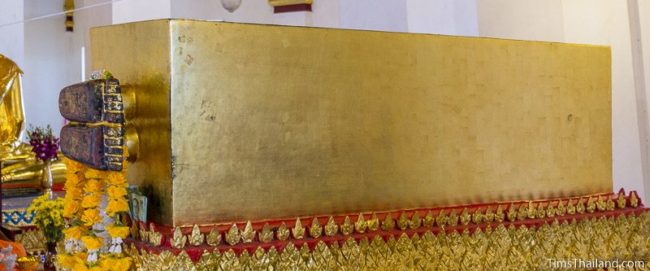
For six days the people of Kusinara paid homage to the Buddha’s body with dance, song, music, flower-garlands, and perfume. On the seventh day after his death, eight men from leading families carried the Buddha’s body through the town, following a winding route demanded by the gods, to a holy shrine outside the east gate for his cremation. Then, as the Buddha had instructed, his body was wrapped with new linen, then with teased cotton wool, and then wrapped again and again; five hundred layers of each. When this was done, the Buddha’s body was placed inside an iron vessel, which itself was placed inside another, and then laid on a pyre made of many kinds of fragrant wood. This was the same ritual used for universal monarchs; kings who had managed to conquer and rule over the whole world.
People tried to light the fire, but the timbers would not burn. The respected elder monk Anuruddha explained that the gods were waiting for Maha Kassapa, one of the Buddha’s top disciples, to come pay his respects. He arrived later that day with five hundred monks, and after they walked around the pyre in salutation three times, the flame ignited itself. In some versions of the story Maha Kassapa wanted to unwrap the Buddha’s body so he could pay proper tribute, but this was not allowed. Instead, the Buddha’s feet emerged miraculously from the coffin, either though Maha Kassapa’s supernatural powers, divine intervention from the gods in heaven, or by the Buddha himself.
Normally the Buddha lies in the coffin on his back, but, as the photo above shows, he is sometimes on his side. Often a statue of Maha Kassapa wais at the Buddha’s feet and sometimes one side of the coffin is not there to allow the Buddha’s body to be seen.
• Thai name: ปางถวายพระเพลิง / Bang Taway Pra Ploeng
Cremation Posture (Variant)
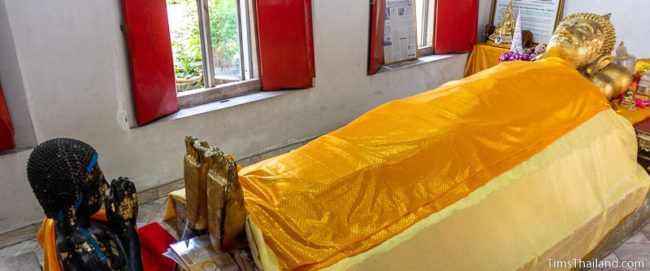
This is an alternate form of the standard Cremation posture shown above, with the exact same story attached. It also often has a Maha Kassapa statue paying respect at the Buddha’s feet. The arms can lie either on the side of the body or on the chest.
• Thai name: ปางถวายพระเพลิง / Bang Taway Pra Ploeng
One thought on “The Reclining Buddhas of Thailand”
Great article thanks, I learnt a lot – plus Tuesday is my wife’s birth day so It useful to know these subtleties!